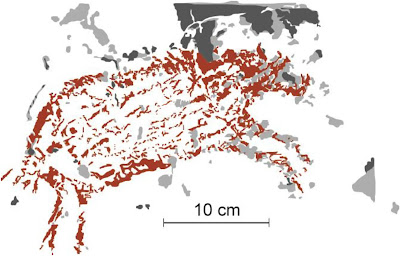It has only been a few months since the reports of the oldest known pictographs were reported in Sulawesi. As I wrote in my February 13 posting of this year (see below) “Rock art researchers in Indonesia have announced the discovery of another candidate for the oldest representative rock art image, a picture of a Sulawesi Warty Pig found in a cave on the island of Sulawesi. ‘The warty pig from Leang Tedongnge cave dates to at least 45,599 years ago, making it the earliest known representational work of art in the world. (Sci-News 2021) Leang Tedongnge cave: The cave is located at the foot of a limestone karst hill. – (The) rock art panel is located on a ledge toward the rear of the cave and features at least three large figurative paintings of pigs.’” (Faris 2021)
Here, we have hardly had time to appreciate the extreme estimated age of these wonderful images, when we are told that they are deteriorating, threatened by climate change. A new report from Sulawesi by Huntley, J., Aubert, M., Oktaviana, A.A. et al. explains that – “The equatorial tropics house some of the earliest rock art yet known, and it is weathering at an alarming rate. Here we present evidence for haloclasty (salt crystallization) from Pleistocene-aged rock art panels at 11 sites in the Maros-Pangkep limestone karsts of southern Sulawesi. We show how quickly rock art panels have degraded in recent decades, contending that climate-catalysed salt efflorescence is responsible for increasing exfoliation of the limestone cave surfaces that house the ~ 45 to 20-thousand-year-old paintings. These artworks are located in the world’s most atmospherically dynamic region, the Australasian monsoon domain. The rising frequency of El Niño-induced droughts from anthropogenic climate change (that is, higher ambient temperatures and more consecutive dry days), combined with seasonal moisture injected via monsoonal rains retained as standing water in rice fields and aquaculture ponds of the region, increasingly provide ideal conditions for evaporation and haloclasty, accelerating rock art deterioration.” (Huntley, J., Aubert, M., Oktaviana, A.A. et al. 2021:1)
“In almost all sites containing early art, the hand stencils and figurative motifs are heavily affected by exfoliation of the limestone cave wall/ceiling surfaces that comprise the artists’ ‘canvas’. The deposition of solutes (chiefly irons, silicones, and calcium carbonates) from the bedrock and surrounding environment concentrate and oxidise at the limestone’s surface, blocking pores to form a mineralized rind – a process known as case-hardening. The case-hardened surfaces of the Maros-Pangkep caves, co-created by biofilms including plentiful microbial mats, regulate water penetration on limestone surfaces, preventing rapid moisture uptake. While case-hardening makes the surface layer more resistant to weathering, the sub-surface zone immediately underneath is weakened by loss of cement matrices, the void spaces becoming susceptible to the accumulation of evaporites such as geological salts, especially where the outer crust has been breached.” (Huntley, J., Aubert, M., Oktaviana, A.A. et al. 2021:2)
Here, in the western United States, rock exfoliation caused by alkali salts is well known, but it is really a shame that the destruction of the oldest rock art currently known in the world is being degraded by a natural process, prompted by human-driven climate change.
NOTE:
An image in this posting was retrieved from the internet with a search for
public domain photographs. If this image is not intended to be public
domain, I apologize, and will happily provide the picture credits if the owner
will contact me with them. For further information on these reports you should
read the original reports at the sites listed below.
REFERENCES:
Faris, Peter, 2021, A New Candidate for the Oldest Pictograph – The Sulawesi Pig, February 13, 2021, https://rockartblog.blogspot.com
Huntley, J., Aubert, M., Oktaviana, A.A. et al., 2021, The Effects of Climate Change on the Pleistocene Rock Art of Sulawesi, Science Reports 11, 9833 (2021), https://doi.org/10.1038/s41598-921987923-3
Sci-News Staff, 2021, 45,000-Year-Old Sulawesi Warty Pig Painting Found in Indonesian Cave, January 14, 2021, http://www.sci-news.com/archaeology/sulawesi-warty-pig-paintings-09250.html






No comments:
Post a Comment